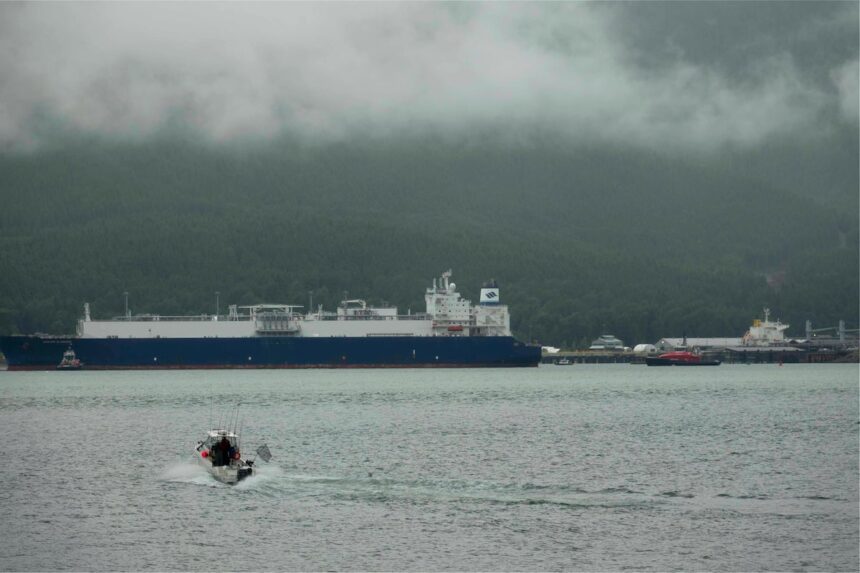I watched the massive carrier slip into view late yesterday afternoon – a ghost through the coastal fog before materializing into 300 meters of gleaming steel. The Minerva Chios, first tanker to dock at LNG Canada’s export terminal in Kitimat, marks not just a business milestone but a turning point in how we define British Columbia’s role in global energy markets.
“We’ve been anticipating this moment for nearly a decade,” said James Tansey, professor at UBC’s Sauder School of Business, as we observed the ship from a nearby vantage point. “This represents the largest private investment in Canadian history, but the implications go far beyond economics.”
The $40-billion LNG Canada project, led by Shell with partners including Petronas and PetroChina, has finally reached the export phase after years of construction and delays. The terminal will eventually ship up to 14 million tonnes of liquefied natural gas annually to Asian markets, primarily Japan and China.
Walking the shoreline near the terminal yesterday, I met Sandra Harris, a Gitxsan elder whose traditional territory lies just inland from the coastal facility. “Our communities have mixed feelings,” she told me, gazing at the enormous vessel. “There are jobs, yes, but many of us worry about what this means for our waters and for climate commitments.”
Her concerns reflect the complex reality of British Columbia’s first major LNG export project. Proponents argue the facility provides cleaner energy to coal-dependent Asian economies while creating economic opportunities in northern B.C. Critics maintain the project undermines Canada’s climate goals and threatens sensitive marine environments.
The Minerva Chios will transport the supercooled natural gas—chilled to approximately -162°C to convert it to liquid form—reducing its volume by 600 times for efficient shipping across the Pacific. This technology allows gas from northeastern B.C. fields to reach markets previously inaccessible by pipeline.
Environmental monitoring data from the B.C. Ministry of Environment shows the terminal’s operations thus far have remained within permitted emissions limits, though long-term impacts remain uncertain. Indigenous monitors from several First Nations have established independent environmental oversight programs alongside provincial regulators.
Crystal Smith, Chief Councillor of the Haisla Nation whose territory encompasses the terminal site, has been a proponent of the project while insisting on strict environmental standards. “This represents economic reconciliation in action,” she stated at a recent community forum. “But make no mistake—we’re watching every aspect of these operations to ensure our lands and waters are protected.”
The economic ripples are already visible in Kitimat, where housing prices have doubled since project construction began. Local restaurants and services have expanded, though some residents worry about sustainability after construction phases end.
“The boom-bust cycle is something northern communities know too well,” explained Dr. Marjorie Cohen, economist at Simon Fraser University who studies resource-dependent communities. “The question isn’t just about this first shipment, but what happens in these towns when the initial construction surge ends.”
Meanwhile, climate scientists express concern about expanding fossil fuel infrastructure. According to the Canadian Climate Institute, meeting Canada’s net-zero emissions target by 2050 requires significant reductions in oil and gas sector emissions—a challenging proposition as production expands.
Yesterday evening, as twilight settled over Douglas Channel, I watched port workers secure the massive vessel. The contrast was striking—this ultra-modern floating technology against the ancient rainforest that has sustained Indigenous communities for millennia.
Kevin O’Reilly, a process engineer who moved to Kitimat for the project three years ago, spoke with me as his shift ended. “People don’t appreciate the engineering marvel this represents,” he said. “The gas that arrives here is purified, cooled to become liquid, then stored in specialized tanks before loading. It’s the culmination of thousands of people’s work over many years.”
The terminal itself, with its towering storage tanks and intricate network of pipes, stands as a testament to industrial ambition. Yet just beyond its fenceline, the wild B.C. coast continues its timeless rhythms—eagles soaring overhead, salmon preparing for their annual runs.
Statistics Canada data shows B.C.’s natural gas production has increased 7.5% in the past five years, much of it destined for this terminal. The province now finds itself at a crossroads—developing resources while trying to meet climate commitments that call for reduced emissions.
For Chief Smith and many in her community, the ship’s arrival represents something else: “This is what economic reconciliation can look like when done properly. We’re partners, not just bystanders.”
As night fell and the lights of the massive ship reflected on the calm waters, the contradictions of this moment were impossible to ignore. The Minerva Chios represents both economic opportunity and environmental question mark, both colonial resource extraction and Indigenous partnership, both global energy transition and continued fossil fuel dependence.
When the ship departs in approximately three days, loaded with Canada’s first major LNG exports, it carries with it not just supercooled natural gas, but these contradictions—and the hopes and concerns of countless British Columbians whose lives and lands are connected to this new energy reality.






